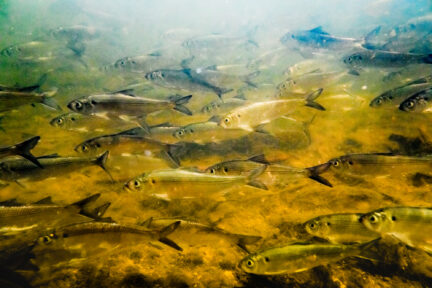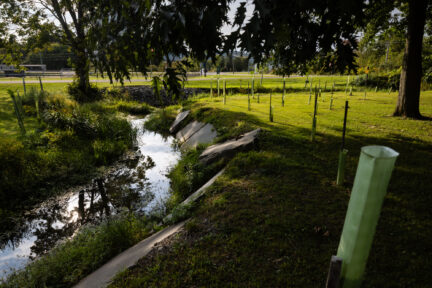Long-Term Nutrient, Sediment Levels Declining in Chesapeake Bay
Long-Term Nutrient, Sediment Levels Declining in Chesapeake Bay
The amount of pollution that flowed from nine major rivers into the Chesapeake Bay in 2013 was below the 25-year average. While scientists expect this to have a positive impact on the long-term health of the nation’s largest estuary, most of the Bay’s tidal waters remain unhealthy: between 2011 and 2013, just 29 percent of the water quality standards necessary to support underwater plants and animals was achieved.
Scientists attribute the lower nitrogen, phosphorus and sediment loads seen in 2013 to below-average river flow and the pollution-reducing practices our partners have put in place on the land. Continuing to lower the amount of nutrient and sediment pollution moving from our streets, lawns, farm fields and wastewater treatment plants into the water is a critical step in the restoration of the Bay. For this reason, the Chesapeake Bay Program tracks both pollution loads and trends in our rivers and progress toward improving water quality in the Bay.
Data show that over the long-term (from 1985 to 2013), concentration trends in nitrogen pollution have improved in five of the nine major rivers that enter the Bay. Long-term concentration trends for phosphorus and sediment pollution have improved in three of these rivers. But the last decade has seen no improvements in phosphorus or sediment concentrations, with several rivers showing degrading conditions.
Water quality in the main Bay is evaluated using three environmental factors: dissolved oxygen, water clarity or underwater grass abundance, and chlorophyll a (a measure of algae growth). Data are assessed in three-year periods, with the most recent period spanning 2011, 2012 and 2013. Although nutrient and sediment levels in rivers improved last year, scientists observed a two percent decrease in the achievement of water quality standards in the Bay, which is likely a result of the challenges underwater grasses have faced over the last five years.
Underwater grasses offer important habitat to underwater species and have a direct impact on water quality: healthy bay grass beds add oxygen to the water, absorb nutrient pollution, reduce wave energy and help suspended and potentially light-blocking particles like sediment settle to the bottom. Between 2009 and 2012, unfavorable growing conditions caused bay grasses to decline across the region. In 2011, for instance, heavy rains and the resulting runoff clouded the water during the spring growing season. That fall, Hurricane Irene and Tropical Storm Lee muddied the water again. This drop in bay grass abundance influenced water quality results. But bay grasses have shown resilience: a dense bed on the Susquehanna Flats persisted through the storms of 2011, and showed how resilient such grass beds can be to disturbances in water quality. If bay grasses continue and sustain the recovery that took place in 2013, we could see healthier Bay waters in the future.
Adjusting our actions on land can also influence clean water. Intensified agriculture and urban and suburban development can push pollution into rivers, streams and the Bay. But pollution-reducing practices—including upgrading wastewater treatment plants, lowering vehicle and power plant emissions, reducing fertilizer use on lawns and installing conservation practices on farmland—can lower our impact on the environment and create cleaner streams and rivers and a healthier Chesapeake Bay.
Facts
Pollution Loads and Trends in Rivers:
The U.S. Geological Survey (USGS) monitors nutrient and suspended sediment pollution loads delivered from the large watersheds located upstream of nine river input monitoring (RIM) stations to the Chesapeake Bay. Together, these stations—which are located on the Appomattox, Choptank, James, Mattaponi, Pamunkey, Patuxent, Potomac, Rappahannock and Susquehanna rivers—reflect loads delivered to the Bay from 78 percent of its 64,000-square-mile watershed.
According to data from the program, nutrient and sediment pollution loads measured in water year 2013 (which took place between Oct. 1, 2012, and Sept. 30, 2013) were below long-term averages. Major results include:
- Nitrogen loads from the nine RIM sites totaled 160 million pounds, which is less than the long-term average of 212 million pounds.
- Phosphorus loads from the nine RIM sites totaled 10 million pounds, which is less than the long-term average of 14.6 million pounds.
- Sediment loads from the nine RIM sites totaled 2.7 million tons, which is less than the long-term average of 5.2 million tons.
The USGS also reports on trends in nutrient and sediment pollution concentrations at these rivers over the long-term (1985-2013) and short-term (last 10 years).
Water Quality Standards Achievement in the Tidal Chesapeake Bay:
The Chesapeake Bay Program measures progress toward the achievement of water quality standards in the Chesapeake Bay and its tidal tributaries using three environmental factors: dissolved oxygen, water clarity or underwater grasses, and chlorophyll a. These data are assessed in three-year periods and combined into a single environmental indicator that tracks changes in Bay health over time. After more than a decade of steady improvement between 1989 and 2002, the attainment of water quality standards has seen mixed results. Changes seen in the past 10 years have shown no statistically significant patterns, fluctuating between 29 and 40 percent. Results of the 2011 to 2013 assessment period indicate that 29 percent of the water quality goals for the Bay were met during this period.
Issues
Excess nutrients and sediment are among the leading causes of the Chesapeake Bay’s poor health. Nitrogen and phosphorus can fuel the growth of algae blooms that lead to long-duration, low-oxygen “dead zones” in deep water and short-duration “mortality moments” in shallow water. Sediment can block sunlight from reaching underwater grasses and suffocate shellfish. Best management practices used in backyards, in cities and on farms can lower the flow of nutrients and sediment into the rivers and streams that feed the Chesapeake Bay.
Importance
By tracking pollution loads into rivers and streams, the Chesapeake Bay Program can ensure its partners are on course to meet the water quality goals of the Chesapeake Bay Watershed Agreement, which includes meeting the limits of the Bay’s “pollution diet,” or Total Maximum Daily Load (TMDL). By measuring the achievement of water quality standards, we can observe changes in Bay health over time. By reporting on these environmental indicators together, we gain a full picture of watershed health.
Quotes
“We have made great progress in implementing nutrient and sediment pollution control measures since the pollution diet, or TMDL, went into effect in 2010. However, these water quality results, which are based on actual water quality monitoring data, make it clear there is more work to do. We are witnessing an ecosystem in recovery. We must accelerate our efforts to make certain we succeed in achieving our water quality objectives.”
--- Nick DiPasquale, Director, Chesapeake Bay Program
“The information collected on nitrogen, phosphorus and sediment loads and trends in the watershed’s nine major rivers provides an important measure of how well our management actions are working to reduce nutrient and sediment pollution throughout the watershed and in the Chesapeake Bay.”
--- Scott Phillips, Chesapeake Bay Coordinator, U.S. Geological Survey (USGS)



